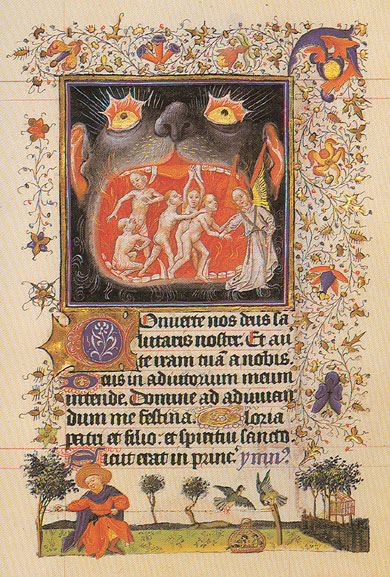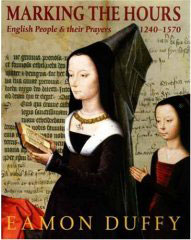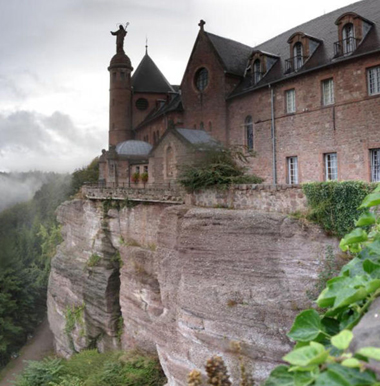Posts from — December 2006
England’s Medieval Books of Hours – A New Book from Eamon Duffy
 Of all the beautiful manuscripts from the Middle Ages that have survived, none is more common than Books of Hours. In fact, it has been said that “Books of Hours are now more widely scattered around the world than any other object made in the Middle Ages” ( from: “A History of Illuminated Manuscripts
Of all the beautiful manuscripts from the Middle Ages that have survived, none is more common than Books of Hours. In fact, it has been said that “Books of Hours are now more widely scattered around the world than any other object made in the Middle Ages” ( from: “A History of Illuminated Manuscripts“). Books of hours provided a framework for lay people to practice monastic devotional routines. After the upheaval of the Black Death in the 14th century, the popularity of the form surged and, by the later Middle Ages, these books were mass produced. One of the most famous and finely painted Book of Hours is the Très Riches Heures. My favorite illustration, however, is from the Hours of Catherine of Cleves, Duchess of Guelders (1417-1476). Shown below, this miniature shows an angel leading figures out of the mouth of Hell.

 If you’re a fan of this type of illustration and calligraphy as I am, you’ll want to get your hands on a copy of a new book published on the Books of Hours by the religious historian Eamon Duffy. “Marking the Hours: English People and Their Prayers, 1240-1570
If you’re a fan of this type of illustration and calligraphy as I am, you’ll want to get your hands on a copy of a new book published on the Books of Hours by the religious historian Eamon Duffy. “Marking the Hours: English People and Their Prayers, 1240-1570” was reviewed in The Guardian recently. Duffy’s new book emphasizes the individual owners of these books. He’s most interested in the personal comments as well as the inclusion of commissioned images of the owners themselves in the beautiful miniatures. These additions are rare glimpses into the individual minds of people from the Middle Ages. From that review:
In the Middle Ages if you were female, comfortably-off and hoped to go to heaven then you almost certainly possessed a Book of Hours. Tucked up your sleeve or kept close by in a special place, the Book was your spiritual guide to the ordinary day. It didn’t speak intimately, nor was it interested in your particular circumstances. Instead it marked the passing of the liturgical “hours” – Matins, Prime, Vespers – giving you a set of prayers and psalms to raise your spirits as you negotiated a schedule more immediately concerned with sulky servants and sickly children than the glories of the Risen Christ.
The review in The Guardian continues:
The kinds of scrawls that people added to their Book of Hours included the names of favourite saints – Apollonia was good for toothache, while Zita was helpful with lost keys. If you were sufficiently rich and important you could get the artist to include a specially commissioned picture of yourself at the front of the book perhaps even – tricksy this – showing yourself reading the very Book of Hours in which you now metaphorically resided. There was even the option of getting yourself inserted into standard biblical scenes. One woman had herself painted as a spectator at the Annunciation, muscling in on Mary and Gabriel’s special moment. Others, more tactfully, waited until the Virgin was actually in heaven and had themselves painted floating on a nearby cloud.
I find this type of history fascinating and I’ve already pre-ordered my copy of Duffy’s book.
[tags]book of hours, eamon duffy, illuminated manuscript, calligraphy, medieval history, middle ages[/tags]
December 30, 2006 Comments Off on England’s Medieval Books of Hours – A New Book from Eamon Duffy
The Mysterious Book Thefts from the 8th-Century Convent of Mont Sainte-Odile

The thefts of hundreds of priceless historic books from the 8th-century convent of Mont Sainte-Odile including dozens of 15th century illuminated manuscripts is a great mystery story. I love books and who doesn’t love intrigue especially a locked room mystery in an 8th century monastery perched on the edge of a peak in Alsace, France. It’s an irresistible combination.
From the Guardian in May, 2002:
The 8th-century convent of Mont Sainte-Odile towers over the picturesque small town of Saverne in the foothills of the Vosges mountains. One of the most popular attractions in Alsace, tens of thousands of people a year tour its abbey, church, chapel and cloisters, dine in its hotel and restaurants and admire the stunning view across the plain to the river Rhine and, beyond, the Black Forest.
Among them, from August 2000, was a curiously well-informed thief. From that date, a succession of immensely valuable works, including precious early religious texts and several dozen heavy 15th-century illuminated manuscripts bound in wood and leather, began disappearing from the abbey’s first-floor library. Police were flummoxed.
Mont Sainte Odile has an exciting history dating from the 2nd century until the present. In 1992, the mountain was struck by an airplane. The monastery, however, is named for an event from that supposedly happened in the 7th century:
In the 7th century Etichon, a merovingian duke, resided in Obernai. His wife Bereswinde, niece of Saint Léger, bishop of Autun and King’s councellor, gave birth to a daughter who was blind . Odile was brought up in Balma Burgundy (Baume-les -Dames) recovers the sight on the day of her baptism.
How did someone steal more than 1000 books from a locked library in an ancient monastery on top of a 2500 foot mountain in France? From the prosecutor as told in the Guardian:
“It was one of those frustrating but also rather thrilling cases,” Madeleine Simoncello, the Saverne public prosecutor, said yesterday. “Quite extraordinary items were vanishing, sometimes singly, sometimes by the dozen. By last weekend over 1,000 had gone, yet the room wasn’t even open to the public and as far as we knew nobody could get in.”
Like a movie, the police went in the library and thumped on the walls and floor searching for a secret passage. One officer, pushing on a plank of wood at the back of a bookcase discovered a secret room. The thief was entering the monastery with tour groups and quietly making his way to a corridor that led to the secret room. From there, he entered the library and quietly chose his books. He piled them neatly on the table in the secret room and came back in the evening to collect his prize. But, with a hidden camera installed, the thief was captured with a suitcase full of priceless medieval manuscripts. The young man had not tried to sell any of the books. Every missing manuscript was found in his home. He wanted them for his own enjoyment. One part of the mystery remains: How did he know about the secret room? From the prosecutor:
“It seems it is mentioned in a highly specialised review,” she said. “This particular issue dealt with some of the oddities of Mont Sainte-Odile. The suspect, who quite clearly adored the abbey, came across it in Strasbourg University library.” The man was one of very, very few people to know of the passageway’s existence, she said.
While no one could approve of stealing these books, it must have been tremendously thrilling. Imagine coming across the information about the passage and the secret room. You would wonder if it really existed. Then, making the trip to the monastery and finding the room and realizing you’re the only one there who knows about it would be too much to bear. Such temptation would be hard to resist.
[tags]Mont Sainte-Odile, 7th century, 8th century, medieval manuscripts, illuminated manuscripts, mystery book thief[/tags]
December 7, 2006 Comments Off on The Mysterious Book Thefts from the 8th-Century Convent of Mont Sainte-Odile

